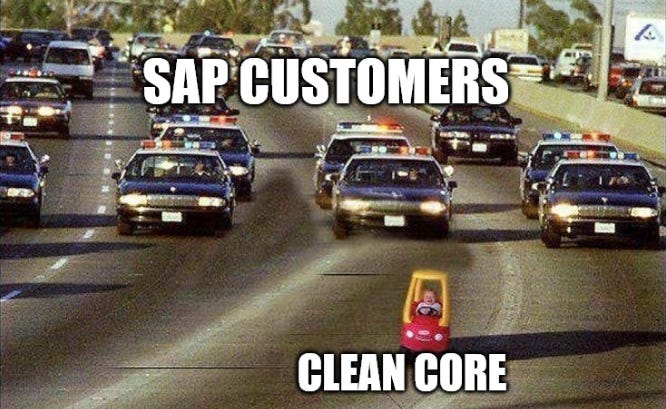#85: How Clean Is Your Core, AI "both sides", Jedi Masters
In this issue:
The Great Clean Core Chase
Welcome back to our continued coverage of The Great Clean Core Chase!
What we know so far: this all began with the now-legendary “Keep the core clean!” announcement live from the SAP TechEd stage. Since then, SAP customers have been in hot pursuit of the Clean Core - which continues to evade capture and remains, for now, at large.
We’re getting breaking news just in: a new tool code-named Project Kernseife has been released, aiming to answer the question on every customer's mind: “how dirty is my core exactly?” Early reports suggest this tool could bring the chase to an end for customers running on S/4HANA with Basis 7.58 or higher. For everyone else, this serves as a grim reminder of the importance of upgrades. Which Clean Core is supposed to make less painful.
Meanwhile, our correspondents in the field are reporting that Clean Core has just fish-tailed onto the interstate. If it gets too close to the API airport’s restricted airspace, we will lose a helicopter and drone coverage. Customers are still in hot pursuit, but concerns are growing over the safety of other drivers on the ERP highway. We’re hearing reports of several close calls - including one near-miss where the IDocs narrowly avoided a fatal collision.
We’ll be keeping our eyes on the road and bringing you updates as the events continue to unfold. Back to you, Paul! JP
Functional Jedi Masters
I was at an S/4HANA Public Cloud workshop for a couple days last week. Got to sit in on fit-to-standard sessions across a few business processes. One session particularly stood out, wherein a woman led a group of five or six people in a discussion of what they ought to do in S/4 with customer return scenarios. And holy heck, chat - this woman was amazing. The session was a delight to be in! I don't say that lightly, because normally I’d rather kiss a rabid badger than sit through a workshop session.
It got me thinking: functional analysts are the people that actually make business systems work. I hate to say it, fellow developer nerds, but they’re way more important than we are. In the spirit of a previous post I did on exemplary architects, I offer below my reflections on the qualities of a great functional analyst.
Empathy for business users. This is actually quite deep. It's rooted in experience, mixing it up in the real world with people who actually, you know, do the thing.
You know how Jedi can sort of see the future, where they can block the blasters with their lightsabers? Great analysts have The Force, but instead of blasters it's weird business edge cases, and instead of lightsabers it's…really good configuration? This metaphor needs work.
Context-switching. To a ridiculous degree. They know, simultaneously, the experience of slinging trailers at a shipping location and the experience of scratching your head in front of a code editor. And then, magically, they make people who live those perspectives sign on to the same vision. They do it by speaking those folks' language, and hot-swapping techie words for business words in a professional version of translator - where the business folks and the nerds use the same words but speak different languages.
Several of the smartest people I've ever worked with played this role at one point in their careers. PM
The Round Tables of ABAP
Where is the SAP Marketing department when you need it? The good folks behind the “SAP BTP ABAP Environment Roundtables” are clearly suffering from bad branding and lack of publicity. Otherwise, I’m not sure how to explain why these events aren’t better known. No matter how technically accurate the name is, I bet many developers won’t even read past “SAP BTP.” “Happy ABAP Fun Times” would generate much more interest, though a name like that would never make it past the watchful eyes of the SAP Department of Killjoy. But I digress.
What might one expect from a Happy ABAP Fun Times™ roundtable? Usually, it’s updates on newly released or upcoming functionality, followed by one or two demos from SAP or partners. This might sound boring, but I found the updates were on point and the demos were actually really, really good.
I’m still working my way through the recordings of past events but so far there was a good demo of ABAP IDE actions, surprising demo of rps Agreement Management that went into the nerd-level technical depths. And even the old (January 2025) demo of Joule for ABAP by Alexander Rother and Jens Weiler was more interesting than other videos I’ve seen on the subject.
If you’re an ABAPer lucky enough to live in a time zone where 10 a.m. CEST isn’t the middle of the night, keep an eye out for the next invite to join live (here is one for August 2025). Being able to ask questions and participate in discussion in real time is the best value of these events. I hope they’ll schedule one at a more US-friendly time in the future, but until then, check out the recordings. JP
Jokers To The Right
Korny Sietsma writes about being stuck in the middle of the hypesters and the haters in the AI coding discussion. As a certified Kool-Aid Drinker of AI Amazingness, I feel it's my sacred duty to weigh in.
And I largely agree! "A lot of the hype is just marketing - astroturfing from fake users, or just plain press releases breathlessly reported by the media" - yes. 100%. Over-hyping is a problem, if for no other reason than that it obscures and obfuscates the actually astonishing things happening.
He sees "quite a few people who have tried the most basic, un-assisted, low-context tools, and get terrible results; and then rule out AI tools as fundamentally broken" - yes. 105%. If you tried the free version of something a year ago, you owe it to yourself to re-test your assumptions. Every major model release across all the big AI labs includes things that push an envelope. You can do things that simply couldn't be done before.
Here's where I disagree: "LLMs are wonderful machines that read your data and questions and produce results in a way that feels like intelligence, but is actually just really clever pattern matching and a surrounding ecosystem of context sources and tools." I honestly can't tell where clever pattern matching and context/tools ends and 'intelligence' begins. PM
Steampunkification
The DC Universe might have Superman and Batman, but the SAP Universe has Lars Hvam Petersen.
Many experienced ABAPers are wondering what the heck ABAP Steampunk is - and how to adopt it. The best way to lean on your existing knowledge while learning something new is a “we used to do X, now we can do Y” format. And while others are still looking around, waiting for SAP to ELI5 it, Lars just went ahead and opened the Steampunkification repo on GitHub.
So there you go, fellow ABAP veterans. In the timeless words of Daft Punk: use it, fix it, now upgrade it. And raise a toast to Lars’s good health. JP
P.S. As this issue was going to press, Lars came out of nowhere with another banger: The Ultimate ABAP Cheatsheet. Some comments questioned if Lars was actually human. I can assure you he is at least real: exhibit A and exhibit B. JP
S/4HANA Cloud Safekeeper
Somehow, in various RISE announcements and posts and marketing blasts and skywriting, I missed S/4HANA Cloud Safekeeper. It's an interesting offering that lets RISE customers who are on ancient versions of S/4HANA get upgraded to the latest version and avoid the nightmarish spectre of customer-specific maintenance.
What strikes me most about this offering is just how complicated things get, even when you're part of a service (RISE) ostensibly created to save you time and effort. Note in the linked piece the two scenarios described (in-place and greenfield/selective data) - you, the customer, have a LOT to do. If I shift my perspective a bit, I see what is likely SAP's most ardent wish: that everyone just gets on full-blown cloud ERP. (I also experience every day why that's not possible.)
There's a regression test service included in Safekeeper, as well. I read the "Exclusions" section of that document and thought…maybe we should just all go back to using Excel for everything? PM
Watch the corresponding Nerdletter Talk on our YouTube channel. Exclusive bonus content is available to the Platinum Plus subscribers only.
Are you interested in sponsoring the Nerdletter and featuring your amazing product? Have a story to share or an angry letter to post? Get in touch on our new and improved website!
This newsletter is proudly written by humans and for humans. Show your support for the last stronghold in the sea of AI slop!








I find a lot of the talk around clean core to be a little amusing. Back at Procter and Gamble in the early 2000s we were already rolling out R/3 based on a global standard template with a minimal developments mindset. For me, clean core is just a buzzword. The real point is 'manage your apps propertly'. I don't think there's anything wrong with developing in the core as long as you have good development standards and good tracking. Most companies are only struggling because of poor undocumented programs and tables all over the place. Lately, I've been thinking that a lot of organisations are blindly running into what I'd call 'fat cloud'.. they might have a clean core, but they are going to end up with an unmanageble list of APIs, interfaces and add ons all doing slight variations of the same thing. I think we need a rational approach to core and cloud.
The real underlying issue is the lack of power of IT senior leadership and enterprise architects to control development. Most organisations are no where near fixing this. For example, the head of customer services still has his own budget to go and buy his own SAAS and hire some unnoficial IT people to work on random integrations.
All the people on LinkedIn complaining about the S/4HANA upgrade being too hard, and too expensive. It's really their own fault, they haven't managed their existing app or budgeted and planned for periodic updates. If I was a CIO I'd have a solid set of upgrades marked out every 5 years or so, so that I never get to the point where I have a 20 year old system that's going to be a nightmare to updgrade.
SAP BTP ABAP Environment Roundtable = facepalm.
I think SAP has always been awful at naming, and as the portfolio of solutions continues to grow it just gets worse. I was just writing a blog about building an integration flow the other day, and I find myself needing to label a box on a diagram as "SAP cloud - business technology platform - integration suite', or should I be nesting those boxes inside each other?
I even think S/4HANA Cloud Public, S/4HANA Cloud Private, and S/4HANA On-Premise is terrible naming. For a start most large organisations are not on-premise, the data centre, hosting, infrastruture is outsourced (HP etc. or more modern Azure etc.). 'Private vs. Public' is also poor, public feels like a 'shared system'. I'd want to see SAP simplify the naming and just call it S/4HANA, then specify deployment options, but in a way that better describes what the customer gets. Public should be named in a way that it's clear innovation goes there first. On-premise should be named in a way that it's clear you get full control.
I like "Happy ABAP fun times". Seriously though, why not just call it "ABAP dev" or something, that would appeal to younger developers. I need to check out those past recordings, I wasn't aware of it either.
My take on AI is it fixes the broken 'web search'. Just the other day working on testing an integration flow I wasn't quite sure how Apache Camel syntax works. I tried reading the documentation, very hard to understand, I tried google search, nothing. I then carefully worded what I was specifically trying to do in Chat GPT and it immediately gave me exactly the right syntax and was able to explain how it breaks down. I like using Chat GPT like this. I never let it write code for me, but when I'm stuck I find that it's a faster 'learning tool' than other traditional methods. I do however worry, that this is affecting my longer term critical thinking and 'research' capability.
Great newsletter!